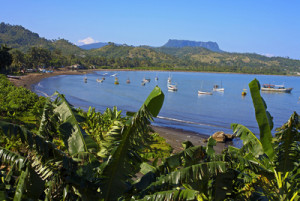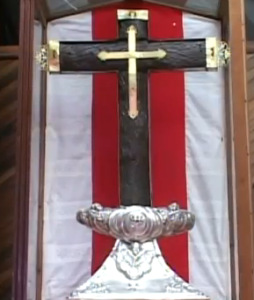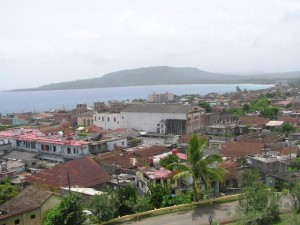BARACOA, NATURAL LUNG OF CUBA. MAGDALENA ROVENSKAYA STORY.
Located almost a thousand kilometers east of Havana, leaning over the Windward Passage, closer to Haiti than in Santiago de Cuba, 95% of its territory is mountainous and the remaining 5% is held by a small coastal strip two kilometers wide, where most of its 82,000 inhabitants live, half of which reside in the municipal capital. With 976 square kilometers roughly half extension Gipuzkoa and the fifth of La Rioja, Baracoa has 28 mountain rivers and one of the most important wetlands in the Caribbean, where species of animals and plants that are not preserved in any elsewhere in the country, as almiquí, Iberia frog-from just nine millimeters, the smallest in the world, or amphibian arboreal species of snail called polymita, fabulous shells yellow, orange or white with black stripes spirals They look painted.
For its natural lung condition, a considerable portion of its territory, within the Alejandro Humboldt Park was declared years ago biosphere reserve and World Heritage by UNESCO. But the character of Baracoa is not given only by his unbridled nature, which is certainly part of the psychology of the people and determines its deliberate gestures as a kind of defense mechanism.
Since Columbus arrived on its shores and planted the Cross of Parra -the only 29 left in America that there is still conservative, he noted in his diary that was found the perfect place to establish a city. The site had no loss, nestled at the foot of “a square anvil-shaped mountain” which today remains the symbol of Baracoa. So it was five hundred fair years ago, August 15, 1511, Diego Velázquez founded Our Lady of the Assumption of Baracoa after ending the Taino endurance and burn at the stake the cacique Hatuey, whose heroic name Cubans become after a brand of beer. In the following years the rest of the first villages, Santiago, Bayamo, Puerto Principe (today Camagüey), Trinidad, Sancti Spiritus, up to the last, Havana, in 1519. But it was founded Baracoa which was inaugurated contemporary history from Cuba.
Baracoa was not only the first capital of the island also hosted the first bishopric and its first mayor was Hernan Cortes. However, the same exaggerated condition that drew the attention of the conquerors and crowned at the beginning, the town caught in a whirlpool and locked itself, isolating the inhabitants of the rest of the country and the world can say that. In its history, Baracoa had few moments of splendor and many of abandonment, and perhaps here that fate made unique traditions and incredible dishes such as bacon, made from banana peel, crab and coconut milk are preserved. Rhythms like nengón kiribá and also preserved the most primitive cells are missing in the rest of the country, and only imaginable characters and legends in places like this.
Baracoa is full of characters, stories and wonderful, true or imaginary stories, anyway, and there are legends past are very much alive, as the feed neighbors to repeat and are part of the imagery of the city.
Among the most celebrated stories is that of Magdalena Rovenskaya, Mima, a white daughter of a tsarist Russian aristocrat who was killed along with most of his family by the Bolsheviks. Miracle escape alive after the revolution, Magdalena landed in Baracoa with her husband in the late twenties. The Russian, which the writer Alejo Carpentier as Vera immortalized in his novel The Rite of Spring, a small hotel built on the boardwalk in Baracoa and it lived up to the triumph of the revolution of Fidel Castro.
The Hotel La Rusa still exists, although since the sixties is the state. Mima’s adopted son, René Frometa, was at home a kind of personal museum with memorabilia of Rovenskaya that thoroughly explains the tourists will change, possibly in convertible pesos or dollars. Although the Russian gave the jewels to the bearded and according to the official version was Fidel, others say he died in 1978 unreconciled entirely with communism. His case still causes some misunderstandings and trouble. On one occasion, an official television broadcaster, remembering his life in an informative said Magdalena “fled of socialism in the Soviet Union and found refuge in Baracoa” (sic). Nothing happened, but in the highest was more than one face of circumstance.
Wikipedia / Various / InternetPhotos / TheCubanHistory.com
The Cuban History, Holywood.
Arnoldo Varona, Editor.
BARACOA, EL PULMÓN NATURAL DE CUBA. LA HISTORIA DE MAGDALENA ROVENSKAYA
Situada a casi mil kilómetros al este de La Habana, asomada al Paso de los Vientos, más cerca de Haití que de Santiago de Cuba, el 95% de su territorio es montañoso y el 5% restante lo ocupa una pequeña franja costera de dos kilómetros de ancho, donde viven la mayor parte de sus 82.000 habitantes, de los cuales la mitad residen en su capital municipal. Con 976 kilómetros cuadrados -aproximadamente la mitad de extensión que Gipuzkoa y la quinta parte de La Rioja-, Baracoa tiene 28 ríos de montaña y uno de los humedales más importantes del Caribe, donde se conservan especies de animales y plantas que no existen en ningún otro lugar del país, como el almiquí, la ranita Iberia -de tan solo nueve milímetros, el anfibio más pequeño del mundo- o una especie de caracol arborícola llamado polymita, de fabulosas conchas amarillas, naranjas o blancas, con espirales de rayas negras que parecen pintadas.
Por su condición de pulmón natural, una porción considerable de su territorio, comprendida en el parque Alejandro de Humboldt, fue declarada hace años reserva de la biosfera y patrimonio de la humanidad por la Unesco. Pero el carácter de Baracoa no le viene dado solo por su naturaleza desbordada, que sin duda es parte de la psicología de sus habitantes y condiciona sus ademanes pausados como una especie de mecanismo de defensa.
Desde que Colón llegó a sus costas y plantó allí la cruz de la Parra -única de las 29 que dejó en América que aún se conserva-, anotó en su diario que el lugar encontrado era ideal para establecer una ciudad. El sitio no tenía pérdida, enclavado a los pies de “una montaña cuadrada con forma de yunque” que hoy sigue siendo el símbolo de Baracoa. Así fue como hace quinientos años justos, el 15 de agosto de 1511, el adelantado Diego Velázquez fundó Nuestra Señora de la Asunción de Baracoa luego de acabar con la resistencia taína y quemar en la hoguera al cacique Hatuey, cuyo nombre heroico los cubanos convertirían después en una marca de cerveza. En los años siguientes se fundaron el resto de las primeras villas, Santiago, Bayamo, Puerto Príncipe (hoy Camaguey), Trinidad, Sancti Spíritus, hasta llegar a la última, La Habana, en 1519. Pero fue Baracoa la que inauguró la historia contemporánea de Cuba.
Baracoa no solo fue la primera capital de la isla, también albergó el primer obispado y su primer alcalde fue Hernán Cortes. Sin embargo, esa misma condición exagerada que llamó la atención de los conquistadores y la coronó al inicio, atrapó a la localidad en un remolino y la encerró en sí misma, aislando a sus habitantes del resto del país y puede decirse que del mundo. En su historia, Baracoa tuvo pocos momentos de esplendor y muchos de abandono, y quizá esa fatalidad hizo que se conservaran aquí tradiciones únicas o platos increíbles como el bacón, hecho a base de ralladura de plátano, cangrejo y leche de coco. También se preservaron ritmos como el kiribá y el nengón, las células más primitivas del son, desaparecidas en el resto del país, y personajes y leyendas solo imaginables en lugares como este.
Baracoa está repleta de personajes, cuentos e historias maravillosas, verdaderas o imaginarias, da igual, y también hay leyendas pasadas que están muy vivas, pues las alimentan los vecinos al repetirlas y son parte del imaginario de la ciudad.
Entre las historias más celebradas está la de Magdalena Rovenskaya, Mima, una rusa blanca hija de un aristócrata zarista que murió junto a gran parte de su familia a manos de los bolcheviques. Tras escapar viva de milagro de la revolución, Magdalena recaló en Baracoa con su marido a finales de los años veinte. La Rusa, que el escritor Alejo Carpentier inmortalizó como Vera en su novela La consagración de la primavera, construyó un hotelito en el malecón de Baracoa y de eso vivió hasta que triunfó la revolución de Fidel Castro.
El hotel La Rusa existe todavía, aunque desde los años sesenta es del Estado. El hijo adoptivo de Mima, René Frometa, se hizo en su casa una especie de museo personal con objetos y recuerdos de Rovenskaya que explica minuciosamente a los turistas cambio de la voluntad, a ser posible en pesos convertibles o dólares. Aunque La Rusa entregó las joyas a los barbudos y según la versión oficial se hizo fidelista, otros aseguran que murió en 1978 sin reconciliarse del todo con el comunismo. Su caso todavía provoca malos entendidos y algunos aprietos. En una ocasión, un locutor de la televisión oficial al recordar su vida en un informativo dijo que Magdalena “salió huyendo del socialismo en la Unión Soviética y encontró refugio en Baracoa” (sic). No pasó nada, pero en las alturas hubo más de una cara de circunstancia.
Wikipedia/rious/InternetPhotos/TheCubanHistory.com
The Cuban History, holywood.
Arnoldo Varona, Editor.



 BARACOA, Natural Lung of Cuba. Magdalena Rovenskaya Story. + BARACOA, El Pulmón Natural de Cuba. La Historia de Magdalena Rovenskaya.
BARACOA, Natural Lung of Cuba. Magdalena Rovenskaya Story. + BARACOA, El Pulmón Natural de Cuba. La Historia de Magdalena Rovenskaya.




